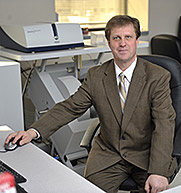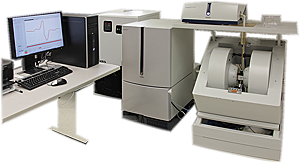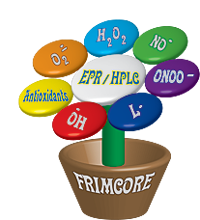 |
|
| Dr. Sergey Dikalov |
|
|
|
|
 EPR machine
EPR machine
|
FRIMCORE is equipped with new state-of-the-art Bruker EMX plus © EPR spectrometer with high sensitivity microwave cavity for detection of ultra-low levels of free radicals in the biological cellular and tissue samples. We perform measurements at room temperature, liquid nitrogen or temperature-controlled system from 180 to 320 °K. X-band EPR spectroscopy allows highest sensitivity free radical detection using spin traps, spin probes or directly measure biological free radicals such as ascorbate radical and nitrosyl hemoglobin. New Linux-based Xenon software provide convenient data acquisition and analysis.
Using EPR spectrometer we offer a varity of services:
1) spin trapping study of superoxide and other free radicals;
2) site specific superoxide measurements by hydroxylamine spin probes;
3) analysis of cellular redox status by reduced thiol spin probes;
4) xanthine oxidase activity assay in cells, tissue and plasma;
5) NADPH oxidase activity assay in cells and tissue;
6) measurements of nitric oxide in vitro using Fe-DETC method;
7) analysis of nitric oxide production in vivo by NO-Hb;
8) study of antioxidant reactions and activity.
We recommend scheduling a meeting prior to EPR service in order to determine the best method and protocol for sample preparation. This service may require training for sample preparation, however, all samples will be processed by FRIMCORE staff. To schedule a meeting or consultation please contact Dr. Sergey Dikalov:
- Dikalov S.I., Mason R.P. (2001) Spin trapping of polyunsaturated fatty acid-derived peroxyl radicals. Reassignment to alkoxyl radical adducts. Free Rad. Biol. Med. 2001,30, 187-197.
- Dikalov S.I., Dikalova A.E., Mason R.P. (2002) Noninvasive diagnostic tool for inflammation-induced oxidative stress using electron spin resonance spectroscopy and an extracellular cyclic hydroxylamine. 2, 218-226.
- Dikalov SI, Kirilyuk IA, Voinov M, Grigor’ev IA. EPR detection of cellular and mitochondrial superoxide using cyclic hydroxylamines. Free RadicRes. 2011;45:417-30.
- Dikalov S., Khramtsov V. and Zimmer G. (1996) Determination of rate constants of the reactions of thiols with superoxide radical by electron paramagnetic resonance: critical remarks on spectrophotometric approaches. Arch. Biochem. Biophys. 326, 207-218.
- Dikalov S, Dikalova A, Bikineyeva AT, Harrison DG, Griendling KK. Distinct roles of Nox1 and Nox4 in basal and angiotensin II-stimulated superoxide and hydrogen peroxide production. Free Radic Biol Med. 2008;45(9):1340-1351.
- Dikalov S.I., Fink B. (2005) ESR techniques for the detection of nitric oxide in vivo and in tissues. Nitric Oxide, Part E, Vol. 396, 597-610.
- Dikalov S, Losik T, Arbiser JL. Honokiol is a potent scavenger of superoxide and peroxyl radicals. Biochem Pharm. 2008;76(5):589-96.
- Dikalova AE, Bikineyeva AT, Budzyn K, Nazarewicz RR, McCann L, Lewis W, Harrison DG, Dikalov SI. Therapeutic Targeting of Mitochondrial Superoxide in Hypertension. Circ Res. 2010; 107:106-116.
|

